Restaurant
A restaurant (French: [ʁɛstoʁɑ̃] (![]()
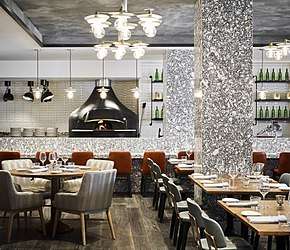
In Western countries, most mid-to high-range restaurants serve alcoholic beverages such as beer and wine. Some restaurants serve all the major meals, such as breakfast, lunch, and dinner (e.g., major fast food chains, diners, hotel restaurants, and airport restaurants). Other restaurants may serve only a single meal (for example, a pancake house may only serve breakfast) or they may serve two meals (e.g., lunch and dinner).
Etymology
The word derives from the French verb "restaurer" ("to restore", "to revive")[2] and, being the present participle of the verb,[3] it literally means "that which restores".[4][5] The term restaurant was defined in 1507 as a "restorative beverage", and in correspondence in 1521 to mean "that which restores the strength, a fortifying food or remedy".[6]
History
The restaurant as it is contemporarily understood did not exist until the end of the 18th century. Sitting down in a public restaurant specifically for a meal, with a waiter and a fixed menu is a relatively recent concept in culinary history.
— Wyatt Constantine, Un Histoire Culinaire: Careme, The Restaurant, and the Birth of Modern Gastronomy[7]
The first use of the word to refer to a public venue where one can order food is believed to be in the 18th century. In 1765, a French chef by the name of A. Boulanger established a business selling soups and other "restaurants" ("restoratives"). Additionally, while not the first establishment where one could order food, or even soups, it is thought to be the first to offer a menu of available choices[8] The "first real restaurant" is considered to have been "La Grande Taverne de Londres" in Paris, founded by Antoine Beauvilliers in either 1782 or 1786.[9][8] According to Brillat-Savarin, this was "the first to combine the four essentials of an elegant room, smart waiters, a choice cellar, and superior cooking".[10][11][12] In 1802 the term was applied to an establishment where restorative foods, such as bouillon, a meat broth, were served ("établissement de restaurateur").[13]
Types
_Kitchen.jpg)
Restaurants are classified or distinguished in many different ways. The primary factors are usually the food itself (e.g. vegetarian, seafood, steak); the cuisine (e.g. Italian, Chinese, Japanese, Indian, French, Mexican, Thai) or the style of offering (e.g. tapas bar, a sushi train, a tastet restaurant, a buffet restaurant or a yum cha restaurant). Beyond this, restaurants may differentiate themselves on factors including speed (see fast food), formality, location, cost, service, or novelty themes (such as automated restaurants). Some of these include fine dining, casual dining, contemporary casual, family style, fast casual, fast food, cafes, buffet, concession stands, food trucks, pop-up restaurants, and ghost restaurants.[14]
Restaurants range from inexpensive and informal lunching or dining places catering to people working nearby, with modest food served in simple settings at low prices, to expensive establishments serving refined food and fine wines in a formal setting. In the former case, customers usually wear casual clothing. In the latter case, depending on culture and local traditions, customers might wear semi-casual, semi-formal or formal wear. Typically, at mid- to high-priced restaurants, customers sit at tables, their orders are taken by a waiter, who brings the food when it is ready. After eating, the customers then pay the bill. In some restaurants, such as workplace cafeterias, there are no waiters; the customers use trays, on which they place cold items that they select from a refrigerated container and hot items which they request from cooks, and then they pay a cashier before they sit down. Another restaurant approach which uses few waiters is the buffet restaurant. Customers serve food onto their own plates and then pay at the end of the meal. Buffet restaurants typically still have waiters to serve drinks and alcoholic beverages. Fast food restaurants are also considered a restaurant. In addition, food trucks are another popular option for people who want quick food service.
Tourists around the world can enjoy dining services on railway cars and cruise ships dining rooms, which are essentially traveling restaurants. Many railways dining services cater to the needs of travelers by providing railway refreshment rooms at railway stations. Many cruise ships provide a variety of dining experiences including a main restaurant, satellites restaurants, room service, specialty restaurants, cafes, bars, and buffets to name a few. Some restaurants on these cruise ships required reservations and specific dress codes.[15]
Restaurant staff
A restaurant's proprietor is called a restaurateur, this derives from the French verb restaurer, meaning "to restore". Professional cooks are called chefs, with there being various finer distinctions (e.g. sous-chef, chef de partie). Most restaurants (other than fast food restaurants and cafeterias) will have various waiting staff to serve food, beverages and alcoholic drinks, including busboys who remove used dishes and cutlery. In finer restaurants, this may include a host or hostess, a maître d'hôtel to welcome customers and to seat them, and a sommelier or wine waiter to help patrons select wines. A new route to becoming a restaurateur, rather than working one's way up through the stages, is to operate a food truck. Once a sufficient following has been obtained, a permanent restaurant site can be opened. This trend has become common in the UK and the US.
Chef's table
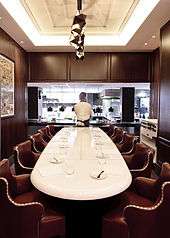
A chef's table is a table located in the kitchen of a restaurant,[16][17] reserved for VIPs and special guests.[18] Patrons may be served a themed[18] tasting menu prepared and served by the head chef. Restaurants can require a minimum party[19] and charge a higher flat fee.[20] Because of the demand on the kitchen's facilities, chef's tables are generally only available during off-peak times.[21]
By country
Asia
China
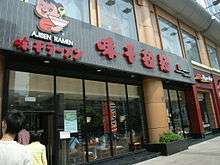
In China, food catering establishments that may be described as restaurants have been known since the 11th century in Kaifeng, China's capital during the first half of the Song dynasty (960–1279). Probably growing out of the tea houses and taverns that catered to travellers, Kaifeng's restaurants blossomed into an industry catering to locals as well as people from other regions of China.[22] There is a direct correlation between the growth of the restaurant businesses and institutions of theatrical stage drama, gambling and prostitution which served the burgeoning merchant middle class during the Song dynasty.[23] Restaurants catered to different styles of cuisine, price brackets, and religious requirements. Even within a single restaurant choice were available, and people ordered the entree from written menus.[22] An account from 1275 writes of Hangzhou, the capital city for the last half of the dynasty:
The people of Hangzhou are very difficult to please. Hundreds of orders are given on all sides: this person wants something hot, another something cold, a third something tepid, a fourth something chilled. one wants cooked food, another raw, another chooses roast, another grill.[24]
The restaurants in Hangzhou also catered to many northern Chinese who had fled south from Kaifeng during the Jurchen invasion of the 1120s, while it is also known that many restaurants were run by families formerly from Kaifeng.[25]
Europe
Greece
In Ancient Greece and Ancient Rome, thermopolia (singular thermopolium) were small restaurant-bars that offered food and drinks to customers. A typical thermopolium had L-shaped counters in which large storage vessels were sunk, which would contain either hot or cold food. Their popularity was linked to the lack of kitchens in many dwellings and the ease with which people could purchase prepared foods. Furthermore, eating out was considered an important aspect of socializing.
Roman Empire
In Pompeii, 158 thermopolia with service counters have been identified throughout the town. They were concentrated along the main axis of the town and the public spaces where they were frequented by the locals.[26]
France
.jpg)
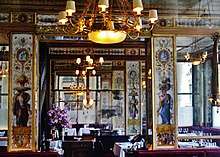
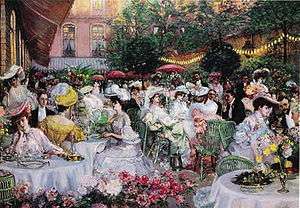
France has had a rich history with the development of various forms of inns and eateries, eventually to form many of the now-ubiquitous elements of the modern restaurant.
As far back as the thirteenth century, inns served a variety of food — bread, cheese, bacon, roasts, usually eaten at a common table. Parisians could buy what was essentially take-out food from rôtisseurs, who prepared roasted meat dishes, and pastry-cooks, who could prepare meat pies and often more elaborate dishes. Municipal statutes stated that the official prices per item were to be posted at the entrance; this was the first official mention of menus.[27]
Taverns also served food, as did cabarets. A cabaret, however, unlike a tavern, served food at tables with tablecloths, provided drinks with the meal, and charged by the customers' choice of dish, rather than by the pot.[28] Cabarets were reputed to serve better food than taverns and a few, such as the Petit Maure, became well-known. A few cabarets had musicians or singing, but most, until the late 19th century, were simply convivial eating places.[27][28] The first café opened in Paris in 1672 at the Saint-Germain fair. By 1723 there were nearly four hundred cafés in Paris, but their menu was limited to simpler dishes or confectionaries, such as coffee, tea, chocolate, ice creams, pastries, and liqueurs.[28]
At the end of the 16th century, the guild of cook-caterers (later known as "traiteurs") was given its own legal status. The traiteurs dominated sophisticated food service, delivering or preparing meals for the wealthy at their residences. Taverns and cabarets were limited to serving little more than roast or grilled meats. Towards the end of the seventeenth century, both inns and then traiteurs began to offer "host's tables" (tables d'hôte), where one paid a set price to sit at a large table with other guests and eat a fixed menu meal.[27]
The earliest modern-format "restaurants" to use that name in Paris were the establishments which served bouillon, a broth made of meat and egg which was said to restore health and vigor. The first restaurant of this kind opened in 1765 or 1766 by Mathurin Roze de Chantoiseau on rue des Poulies, now part of the Rue de Louvre.[29] The name of the owner is sometimes given as Boulanger.[30] Unlike earlier eating places, it was elegantly decorated, and besides meat broth offered a menu of several other "restorative" dishes, including macaroni. Chantoiseau and other chefs took the title "traiteurs-restaurateurs".[30]
In June 1786 the Provost of Paris issued a decree giving the new kind of eating establishment official status, authorizing restaurateurs to receive clients and to offer them meals until eleven in the evening in winter and midnight in summer.[30] Ambitious cooks from noble households began to open more elaborate eating places. The first luxury restaurant in Paris, the Taverne Anglaise, was opened at the Palais-Royal at the beginning of 1786, shortly before the French Revolution, by Antoine Beauvilliers, the former chef of the Count of Provence, It had mahogany tables, linen tablecloths, chandeliers, well-dressed and trained waiters, a long wine list and an extensive menu of elaborately prepared and presented dishes.[30]
The French Revolution caused a mass emigration of nobles, and many of their cook chose to open restaurants.[31] One restaurant was started in 1791 by Méot, the former chef of the Duke of Orleans, which offered a wine list with twenty-two choices of red wine and twenty-seven of white wine. By the end of the century there were a collection of luxury restaurants at the Grand-Palais: Huré, the Couvert espagnol; Février; the Grotte flamande; Véry, Masse and the Café de Chartres (still open, now Le Grand Vefour)[30]
In the early 19th century traiteurs and restaurateurs, became known simply as "restaurateurs". The use of the term "restaurant" for the establishment itself only became common in the nineteenth century). The first restaurant guide, called Almanach des Gourmandes, written by Grimod de La Reyniére, was published in 1804. During the French Restoration period, the most celebrated restaurant was the Rocher de Cancale, frequented by the characters of Balzac. In the middle of the century, Balzac's characters moved to the Cafe Anglais, which in 1867 also hosted the famous Three Emperors Dinner hosted by Napoleon III in honor of Tsar Alexander II, Kaiser Wilhelm I and Otto von Bismarck during the Exposition Universelle in 1867[32] Other restaurants that occupy a place in French history and literature include Maxim's and Fouquet's. The restaurant of Hotel Ritz Paris, opened in 1898, was made famous by its chef, Auguste Escoffier. The 19th century also saw the appearance of new kinds of more modest restaurants, including the bistrot. The brasserie featured beer and was made popular during the 1867 Paris Exposition.[30]
The Americas
Brazil
In Brazil, restaurants varieties mirrors the multitude of nationalities that arrived in the country: Japanese, Arab, German, Italian, Portuguese and many more.
Colombia
In Colombia, a piqueteadero is a type of casual or rustic eatery.[33] Meals are often shared, and typical offerings include dishes such as chorizo, chicharrón, fried organs, fried yuca, maduro and corn on the cob. Customers order the foods they want and the prepared foods are served together on a platter to be shared.[33] The word piquete can be used to refer to a common Colombian type of meal that includes meat, yuca and potatoes, which is a type of meal served at a piqueteaderos. The verb form of the word piquete, piquetear, means to participate in binging, liquor drinking, and leisure activities in popular areas or open spaces.[34]
Peru
In Peru, many indigenous, Spanish, and Chinese dishes are frequently found. Because of recent immigration from places such as China, and Japan, there are many Chinese and Japanese restaurants around the country, especially in the capital city of Lima.
United States
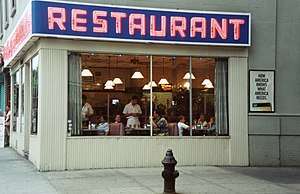
In the United States, it was not until the late 18th century that establishments that provided meals without also providing lodging began to appear in major metropolitan areas in the form of coffee and oyster houses. The actual term "restaurant" did not enter into the common parlance until the following century. Prior to being referred to as "restaurants" these eating establishments assumed regional names such as "eating house" in New York City, "restorator" in Boston, or "victualing house" in other areas. Restaurants were typically located in populous urban areas during the 19th century and grew both in number and sophistication in the mid-century due to a more affluent middle class and to suburbanization. The highest concentration of these restaurants were in the West, followed by industrial cities on the Eastern Seaboard.
In the 1970s, there was one restaurant for every 7,500 persons. In 2016, there were 1,000,000 restaurants; one for every 310 people. The average person eats out five to six times weekly. 10% of the nation's workforce is composed of restaurant workers.[36] According to a Gallup Poll in 2016, nearly 61% of Americans across the country eat out at a restaurant once a week or more, and this percent is only predicted to increase in future years.[37] Before the COVID-19 pandemic, The National Restaurant Association estimated restaurant sales of $899 billion in 2020. The association now projects that the pandemic will decrease that to $675 billion, a decline of $274 billion over their previous estimate.[38]
Guides
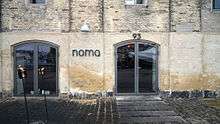
Restaurant guides review restaurants, often ranking them or providing information to guide consumers (type of food, handicap accessibility, facilities, etc.). One of the most famous contemporary guides is the Michelin series of guides which accord from 1 to 3 stars to restaurants they perceive to be of high culinary merit. Restaurants with stars in the Michelin guide are formal, expensive establishments; in general the more stars awarded, the higher the prices.
The main competitor to the Michelin guide in Europe is the guidebook series published by Gault Millau. Its ratings are on a scale of 1 to 20, with 20 being the highest.
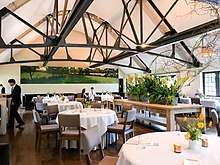
In the United States, the Forbes Travel Guide (previously the Mobil travel guides) and the AAA rate restaurants on a similar 1 to 5 star (Forbes) or diamond (AAA) scale. Three, four, and five star/diamond ratings are roughly equivalent to the Michelin one, two, and three star ratings while one and two star ratings typically indicate more casual places to eat. In 2005, Michelin released a New York City guide, its first for the United States. The popular Zagat Survey compiles individuals' comments about restaurants but does not pass an "official" critical assessment. FreshNYC recommends plausible New York City restaurants for busy New Yorkers and visitors alike.[39]
The Good Food Guide, published by the Fairfax Newspaper Group in Australia,[40] is the Australian guide listing the best places to eat. Chefs Hats are awarded for outstanding restaurants and range from one hat through three hats. The Good Food Guide also incorporates guides to bars, cafes and providers. The Good Restaurant Guide is another Australian restaurant guide that has reviews on the restaurants as experienced by the public and provides information on locations and contact details. Any member of the public can submit a review.
Nearly all major American newspapers employ food critics and publish online dining guides for the cities they serve. Some news sources provide customary reviews of restaurants, while others may provide more of a general listings service.
More recently Internet sites have started up that publish both food critic reviews and popular reviews by the general public.
Economics
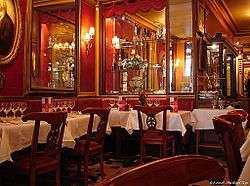
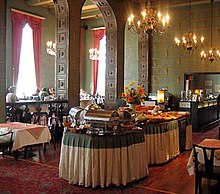
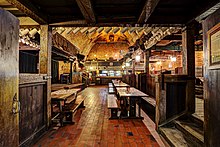
Many restaurants are small businesses, and franchise restaurants are common. There is often a relatively large immigrant representation, reflecting both the relatively low start-up costs of the industry (thus making restaurant ownership an option for immigrants with relatively few resources) and the cultural importance of food.
India
Indian restaurant industry is highly fragmented with more than 1.5 million outlets of which only around 3000 of them are from the organized segment.[41] Organized segment includes Quick Service Restaurants (QSRs), Casual Dining, Cafes, Fine Dining and Pubs, Bars, Clubs and Lounges.
Canada
There are 86,915 commercial foodservice units in Canada, or 26.4 units per 10,000 Canadians. By segment, there are:[42]
- 38,797 full-service restaurants
- 34,629 limited-service restaurants
- 741 contract and social caterers
- 6,749 drinking places
Fully 63% of restaurants in Canada are independent brands. Chain restaurants account for the remaining 37%, and many of these are locally owned and operated franchises.[43]
European Union
The EU-27 has an estimated 1.6m businesses involved in 'accommodation & food services', more than 75% of which are small and medium enterprises.[44]
United States
As of 2006, there are approximately 215,000 full-service restaurants in the United States, accounting for $298 billion in sales, and approximately 250,000 limited-service (fast food) restaurants, accounting for $260 billion.[45] Starting in 2016, Americans spent more on restaurants than groceries.[46] In October 2017, The New York Times reported there are 620,000 eating and drinking places in the United States, according to the Bureau of Labor Statistics. They also reported that the number of restaurants are growing almost twice as fast as the population.[47]
One study of new restaurants in Cleveland, Ohio found that 1 in 4 changed ownership or went out of business after one year, and 6 out of 10 did so after three years. (Not all changes in ownership are indicative of financial failure.)[48] The three-year failure rate for franchises was nearly the same.[49]
Restaurants employed 912,100 cooks in 2013, earning an average $9.83 per hour.[50] The waiting staff numbered 4,438,100 in 2012, earning an average $8.84 per hour.[51]
Jiaxi Lu of the Washington Post reports in 2014 that, "Americans are spending $683.4 billion a year dining out, and they are also demanding better food quality and greater variety from restaurants to make sure their money is well spent."[52]
Dining in restaurants has become increasingly popular, with the proportion of meals consumed outside the home in restaurants or institutions rising from 25% in 1950 to 46% in 1990. This is caused by factors such as the growing numbers of older people, who are often unable or unwilling to cook their meals at home and the growing number of single-parent households. It is also caused by the convenience that restaurants can afford people; the growth of restaurant popularity is also correlated with the growing length of the work day in the US, as well as the growing number of single parent households.[53] Eating in restaurants has also become more popular with the growth of higher income households. At the same time, less expensive establishments such as fast food establishments can be quite inexpensive, making restaurant eating accessible to many.
Employment
The restaurant industry in the United States is large and quickly growing, with 10 million workers. 1 in every 12 U.S. residents work in the business, and during the 2008 recession, the industry was an anomaly in that it continued to grow. Restaurants are known for having low wages, which they claim are due to thin profit margins of 4-5%. For comparison, however, Walmart has a 1% profit margin.[54] As a result of these low wages, restaurant employees suffer from three times the poverty rate as other U.S. workers, and use food stamps twice as much.[54] Restaurants also employ marginalized groups. They are the largest employer of people of color. Restaurants rank as the second largest employer of immigrants. These workers statistically are concentrated in the lowest paying positions in the restaurant industry. In the restaurant industry, 39% of workers earn minimum wage or lower.[54]
Regulations
In many countries, restaurants are subject to inspections by health inspectors to maintain standards for public health, such as maintaining proper hygiene and cleanliness. As part of these inspections, cooking and handling practices of ground beef are taken into account to protect against the spread of E coli poisoning. The most common kind of violations of inspection reports are those concerning the storage of cold food at appropriate temperatures, proper sanitation of equipment, regular hand washing and proper disposal of harmful chemicals. Simple steps can be taken to improve sanitation in restaurants. As sickness is easily spread through touch, restaurants are encouraged to regularly wipe down tables, door knobs and menus.[55]
Depending on local customs, legislation and the establishment, restaurants may or may not serve alcoholic beverages. Restaurants are often prohibited from selling alcoholic beverages without a meal by alcohol sale laws; such sale is considered to be activity for bars, which are meant to have more severe restrictions. Some restaurants are licensed to serve alcohol ("fully licensed"), or permit customers to "bring your own" alcohol (BYO / BYOB). In some places restaurant licenses may restrict service to beer, or wine and beer.[56]
Occupational hazards
Food service regulations have historically been built around hygiene and protection of the consumer's health.[57] However, restaurant workers face many health hazards such as long hours, low wages, minimal benefits, discrimination, high stress, and poor working conditions.[57] Along with the COVID-19 pandemic, much attention has been drawn to the prevention of community transmission in restaurants and other public settings.[58] To reduce airborne disease transmission, the Centers for Disease Control and Prevention recommends reduced dining capacity, face masks, adequate ventilation, physical barrier installments, disinfection, signage, and flexible leave policies for workers.[59]
See also
References
- "Definition of RESTAURANT". Merriam-Webster.
- "restaurer". Wiktionary.
- "Conjugaison de restaurer - WordReference.com". wordreference.com.
- "restaurer - traduction -". Dictionnaire Français-Anglais WordReference.com.
- "restaurer - Conjugation of verb restaurer". Le Conjugueur Conjugaison.
- "ce qui répare les forces, aliment ou remède fortifiant" (Marguerite d'Angoulême ds Briçonnet, volume 1, p. 70)
- Constantine, Wyatt (May 2012). "Un Histoire Culinaire: Careme, the Restaurant, and the Birth of Modern Gastronomy". Texas State University-San Marcos.
- "Restaurant". Encyclopedia Britannica.
- Prosper Montagné. "The New Larousse Gastronomique". Éditions Larousse. p. 97. Retrieved February 22, 2019.
- Jean Anthelme Brillat-Savarin (April 5, 2012). The Physiology of Taste. Courier Corporation. pp. 226–. ISBN 978-0-486-14302-6.
- Paul H. Freedman; Professor Paul Freedman (2007). Food: The History of Taste. University of California Press. pp. 305–. ISBN 978-0-520-25476-3.
- Edward Glaeser (February 10, 2011). Triumph of the City: How Our Greatest Invention Makes Us Richer, Smarter, Greener, Healthier, and Happier. Penguin Publishing Group. pp. 88–. ISBN 978-1-101-47567-6.
- "Etymology of Cabaret". Ortolong: site of the Centre National des Resources Textuelles et Lexicales (in French). Retrieved January 12, 2019.
- "Types of Restaurants". WebstaurantStore. Retrieved April 22, 2020.
- "Beginner's guide to dining on a cruise". Cruiseable. May 7, 2014. Retrieved April 22, 2020.
- Ford, Elise Hartman (2006). Frommer's Washington, D.C. 2007, Part 3. 298. John Wiley and Sons. p. 162. ISBN 978-0-470-03849-9.
- Blackwell, Elizabeth Canning (2008). Frommer's Chicago 2009. 627. Frommer's. p. 123. ISBN 978-0-470-37371-2.
- Brown, Monique R. (January 2000). "Host your own chef's table". Black Enterprise. p. 122.
- Ford, Elise Hartman; Clark, Colleen (2006). D.C. night + day, Part 3. ASDavis Media Group. p. 25. ISBN 978-0-9766013-4-0.
- Miller, Laura Lea (2007). Walt Disney World & Orlando For Dummies 2008. For Dummies. p. 157. ISBN 978-0-470-13470-2.
- Brown, Monique R. (January 2000). "New spin on dining: Hosting a chef's table can wow guests". Black Enterprise. p. 122.
- Gernet (1962:133)
- West (1997:69–76)
- Kiefer (2002:5–7)
- Gernet (1962:133–134)
- Ellis, Steven J. R. (2004): "The Distribution of Bars at Pompeii: Archaeological, Spatial and Viewshed Analyses", Journal of Roman Archaeology, Vol. 17, pp. 371–384 (374f.)
- Chevallier 2018, pp. 67-80.
- Fierro 1996, p. 737.
- Rebecca L. Spang, The Invention of the Restaurant: Paris and Modern Gastronomic Culture (Harvard University Press, 2001), ISBN 978-0-674-00685-0
- Fierro 1996, p. 1137.
- Metzner, Paul. Crescendo of the Virtuoso: Spectacle, Skill, and Self-Promotion in Paris during the Age of Revolution. Berkeley: University of California Press, c1998 1998. Crescendo of the Virtuoso
- "Dîner des Trois Empereurs le 4 juin 1867". menus.free.fr.
- Bogotá Eater (June 8, 2009). "Piqueteadero 'El Chorote'". Bogotá Eats & Drinks.
- Diccionario Comentado Del Español; Actual en Colombia. 3rd edition. by Ramiro Montoya
- Leonard, Suzy Fleming (October 2, 2016). "Refining fine dining". Florida Today. Melbourne, Florida. pp. 1A, 6A, 7A. Retrieved October 12, 2016.
- "Americans' Dining-Out Frequency Little Changed From 2008". Gallup. January 11, 2017. Retrieved April 2, 2020.
- Gangitano, Alex (March 18, 2020). "Restaurant industry estimates $225B in losses from coronavirus". The Hill. Retrieved March 23, 2020.
- "Things to do in NYC". FreshNYC. Retrieved August 1, 2015.
- "Best Modern Australian Restaurants in Melbourne". Retrieved September 25, 2016.
- "Restaurant Industry". SMERGERS Industry Watch. Retrieved August 27, 2019.
- CRFA's Provincial InfoStats and Statistics Canada
- ReCount/NPD Group and CRFA's Foodservice Facts
- "Business economy – size class analysis – Statistics Explained". Epp.eurostat.ec.europa.eu. Retrieved May 2, 2013.
- 2006 U.S. Industry & Market Outlook by Barnes Reports.
- Phillips, Matt (June 16, 2016). "No one cooks anymore". Quartz (publication). Retrieved April 5, 2017.
- Abrams, Rachel; Gebeloff (October 31, 2017). "Thanks to Wall St., There May Be Too Many Restaurants". The New York Times. Retrieved November 1, 2017.
- Kerry Miller, "The Restaurant Failure Myth", Business Week, April 16, 2007. Cites an article by H.G. Parsa in Cornell Hotel & Restaurant Administration Quarterly, published August 2005.
- Miller, "Failure Myth", page 2
- Bureau of Labor Statistics, "Occupational Employment and Wages, May 2013 35-2014 Cooks, Restaurant" online
- BLS, "Occupational Outlook Handbook: Food and Beverage Serving and Related Workers" (January 8, 2014) online
- Jiaxi Lu, "Consumer Reports: McDonald's burger ranked worst in the U.S.,"
- Nestle, Marion (1994). "Traditional Models of Healthy Eating: Alternatives to 'techno-food'". Journal of Nutrition Education. 26 (5): 241–45. doi:10.1016/s0022-3182(12)80898-3.
- Jayaraman, Saru (Summer 2014). "Feeding America: Immigrants in the Restaurant Industry and Throughout the Food System Take Action for Change". Social Research. 81 (2).
- Sibel Roller (2012). "10". Essential Microbiology and Hygiene for Food Professionals. CRC Press. ISBN 9781444121490.
- Danny May; Andy Sharpe (2004). The Only Wine Book You'll Ever Need. Adams Media. p. 221. ISBN 9781440518935.
- Lippert, Julia; Rosing, Howard; Tendick‐Matesanz, Felipe (July 2020). "The health of restaurant work: A historical and social context to the occupational health of food service". American Journal of Industrial Medicine. 63 (7): 563–576. doi:10.1002/ajim.23112. ISSN 0271-3586.
- Morawska, Lidia; Tang, Julian W.; Bahnfleth, William; Bluyssen, Philomena M.; Boerstra, Atze; Buonanno, Giorgio; Cao, Junji; Dancer, Stephanie; Floto, Andres; Franchimon, Francesco; Haworth, Charles (September 1, 2020). "How can airborne transmission of COVID-19 indoors be minimised?". Environment International. 142: 105832. doi:10.1016/j.envint.2020.105832. ISSN 0160-4120. PMC 7250761. PMID 32521345.
- "Communities, Schools, Workplaces, & Events". Centers for Disease Control and Prevention. April 30, 2020. Retrieved July 14, 2020.
Bibliography
- Chevallier, Jim (2018). A History of the Food of Paris: From Roast Mammoth to Steak Frites. Big City Food Biographies. Rowman & Littlefield. ISBN 978-1442272828.
- Fierro, Alfred (1996). Histoire et dictionnaire de Paris. Robert Laffont. ISBN 978-2221078624.
- Gernet, Jacques (1962). Daily Life in China on the Eve of the Mongol Invasion, 1250–1276. Stanford: Stanford University Press. ISBN 978-0-8047-0720-6.
- Spang, Rebecca L. (2000), The Invention of the Restaurant. Harvard University Press
- West, Stephen H. (1997). "Playing With Food: Performance, Food, and The Aesthetics of Artificiality in The Sung and Yuan". Harvard Journal of Asiatic Studies. 57 (1): 67–106. doi:10.2307/2719361. JSTOR 2719361.
- "Early Restaurants in America". UNLV Libraries Digital Collections. University of Nevada Las Vegas. Retrieved April 30, 2013.
Further reading
- Appelbaum, Robert, Dishing It Out: In Search of the Restaurant Experience. (London: Reaktion, 2011).
- Fleury, Hélène (2007), "L'Inde en miniature à Paris. Le décor des restaurants", Diasporas indiennes dans la ville. Hommes et migrations (Number 1268–1269, 2007): 168–73.
- Haley, Andrew P. Turning the Tables: Restaurants and the Rise of the American Middle Class, 1880–1920. (University of North Carolina Press; 2011) 384 pp
- Kiefer, Nicholas M. (August 2002). "Economics and the Origin of the Restaurant" (PDF). Cornell Hotel and Restaurant Administration Quarterly. 43 (4): 5–7. doi:10.1177/0010880402434006.
- Lundberg, Donald E., The Hotel and Restaurant Business, Boston : Cahners Books, 1974. ISBN 0-8436-2044-7
- Sitwell, William The Restaurant: A 2,000-Year History of Dining Out (2020).[1]
- Whitaker, Jan (2002), Tea at the Blue Lantern Inn: A Social History of the Tea Room Craze in America. St. Martin's Press.
External links


- "William Sitwell books and biography". Waterstones. Retrieved November 20, 2019.